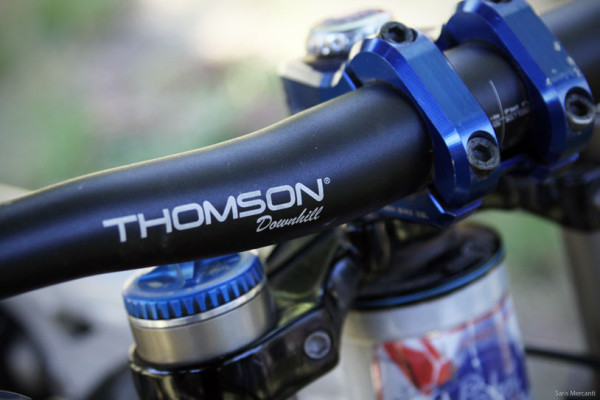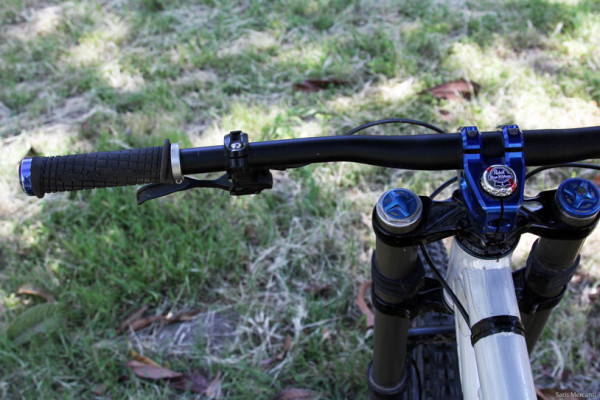While it seems every bicycle component manufacturer now has their own line of stems and seatposts, there is one American company who’s products have often been heralded as the gold standard. While they may not make the lightest or flashiest of products, Thomson (factory tour here) has managed to earn a special reputation among cycling enthusiasts for their high quality products and excellent customer service.
Recently, the company has begun to expand their market share by introducing a full range of handlebars and dropper posts.
Here at BikeRumor, we’ve been flogging two of the new handlebars for over a year. On the cross side, Tyler has had the Kate F’n Compton Carbon CX Bars mounted to his Titanium Project Monstercross Moots, and I’ve been rallying the downhill bar on several different test bikes.
Weight

Weight for the aluminum handlebar is 298 g, which is 3 paper clips more than claimed, which is relatively light for an aluminum bar.
During the development stages, Thomson toyed with the idea of building their downhill bar out of carbon, but felt that aluminum was a better option for the high stress and big consequence nature of the the discipline.
They claim that the advantage of going with aluminum is that in event of a big crash, the bars will bend. In which case, it’s visually obvious that it’s time to replace your setup. With carbon, the fear is that a crash could cause imperceptible damage, that could lead to catastrophic failure down the road.
TECH
The majority of downhill bars on the market today are 800mm wide. Few riders demand anything wider, and that size offers riders the flexibility of trimming their bars down to their preferred width.
Bucking that trend, the Thomson Downhill bars are only 780 mm wide. This width is fine for your average rider, but those who demand something wider should obviously look elsewhere.
In addition to the Downhill handlebar, Thomson also makes a trail version which features the same sweep and rise, but is only 750mm wide. This handlebar is 30 grams lighter, but both retail for $109.95.
The bars have 12mm of rise, 6° of back sweep, and 4° of up sweep, and are only available in a 31.8mm diameter. The center section has a 65mm wide clamping area, so they are compatible with virtually every stem on the market.
Unlike it’s traditional products, the new Thomson handlebars are made outside of the United States. This is because the construction of the aluminum and carbon products required expensive and specialized machinery that they company does not currently have here in the US. The specialized machinery enables their partner to do hydraulic press forging, which avoids the post-production grinding that can weaken aluminum handlebars. The process also ensures consistent wall thickness and better tolerances.
In addition to being forged, the bar is also extensively butted and tapared, for optimized weight, stiffness, and fatigue life. Towards the end of the bar, the aluminum actually thickens from 1.4mm to 1.6 mm.
On the (DH) Trail
The first thing you notice about these bars is the backsweep. While the majority of handlebars we’ve ridden have a more traditional 9°x5° sweep, the Thomson bars run a 6°x4°. The common trend is that as bars have gotten wider, backsweep has increased marginally to compensate. By using a reduced sweep, this handlebar places you further forward on the bike, which works well in conjunction with the modern trend towards ultra slack geometries.
Once mounted to the front end of a DH bike, it only took a few runs to acclimate to the unusual angles. For a trail bike, I’m not sure I could get away with this sweep as it put more pressure on my wrists, but it’s hard to say without cutting them down and trying it out for at a few rides.
Pointed downhill, the bars provide excellent leverage and felt plenty stiff. Despite a few crashes and an entire season of abuse, the matte finish has also emerged unscathed. If you can get past the unusual sweep and don’t need a 800 mm handlebar, the Thomson Downhill Bar is worth a look.
For more, visit Thomson



